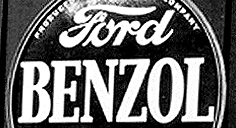Company Milestones
Company MilestonesOur History of Alternative Fuel Innovations
Today, we’re deeply involved in research and development of alternative fuels for the future, including plug-in hybrids, hydrogen and hydrogen fuel cells. We devote a significant percentage of our scientific research budget to environmental efforts toward a world where motorized transportation is cleaner, more fuel efficient and generally less harmful to the natural environment.

Following Henry Ford’s Lead
Our involvement in the development of alternative fuel vehicles has a long history, beginning with our founder, Henry Ford. Besides being an industrialist, Ford was a conservationist who preferred harnessing nature as an energy source and using zero-emission hydroelectric energy.
In researching and developing alternative fuel vehicles in the late 20th and early 21st centuries, we were following the path laid out to us by Henry Ford:
- Henry Ford designed a Fordson tractor that would burn alcohol as well as fossil fuel, but never managed to put this model into production, due to high distillation costs.
- From 1932 to 1942, we produced our own brand of alternative fuel called “Benzol.”
- During the Great Depression, Henry Ford looked for ways to recycle waste created by his factories and to help relieve the fuel burden on the public. By mixing one part light oil, a byproduct from the coal in coke ovens, and three parts gasoline, Ford created a fuel that could run automobiles. This fuel was very popular in the Detroit area, although it was never available nationally. With the United States’ entry into World War II, Ford Motor Company discontinued civilian vehicle and fuel production to join the war effort.
- As early as the mid-1960s, we started offering trucks powered by propane, an inexpensive fuel that eliminated the need for almost all emissions controls. By the early 1980s, there were propane-powered Ford cars and trucks on the road in Canada and the United States.
- In 1981, Ford researchers and engineers developed a modified Econoline van that was North America's first hybrid. It had a traditional internal combustion engine supplemented by an environmentally friendly, battery-powered electric motor for extra power without requiring extra fuel.
- Since 1981, we have maintained a fleet of experimental vehicles that operate on alcohol (ethanol and methanol), compressed natural gas, propane, electricity and selected combinations of fuels. Some of these have seen commercial production, such as 40,000 ethanol-fueled Fords sold in Brazil.
- We built our first natural gas-powered passenger cars in 1993. By the late 1990s, we were selling natural-gas taxis for use in several U.S. cities and fleets of natural-gas vans for use at airports and by utility companies. The U.S. Postal Service has used hundreds of delivery trucks based on the Ford Ranger that run on battery-supplied electricity alone, with no gasoline required.
Ford is a Leader in Alternative Fuel Technology
By the late 20th century, and on into the early 21st century, more than 90 percent of the alternative fuel vehicles sold in the world were Fords. Today, we sell alternative fuel vehicles that range from natural gas-powered vans to flexible-fuel vehicles that run on gasoline and methanol, as well as bi-fuel vehicles that use gasoline or liquefied petroleum gas (LPG). Some of our most popular vehicles are offered in bi-fuel or flexible-fuel versions.
In 2005, we made history with the introduction of the first hybrid-electric SUV in the world – the Escape Hybrid. The Escape Hybrid was designed to be durable and reliable, with as close to zero emissions as possible, and has proved to be extremely popular.
Looking Ahead
As research continues, new possibilities are being explored, including hybrids that combine an electric motor with fuel cells, hydrogen-powered vehicles, and various combinations of power sources. As in the early days of the company, our goal is to develop transportation that is sustainable, affordable and practical for use by millions of people around the world.
Historic Sites

The Rouge
Ford's Rouge Complex is known as an industrial trend-setter in both the 20th and 21st centuries.
Inn on the Tarmac
More than 90 years, the Dearborn Inn was one of the first airport hotels.
Fair Lane: Where The Fords Called "Home"
Henry and Clara Ford's final home, Fair Lane, included a hydroelectric powerhouse and nature areas and is still a landmark today.












